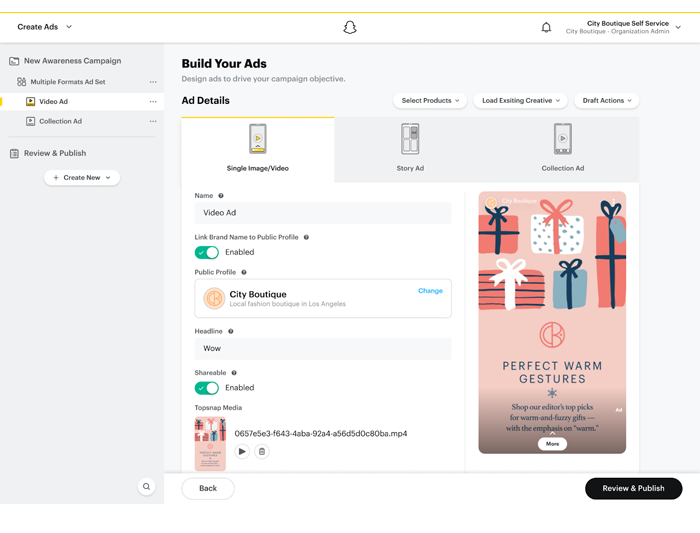Snap is bringing more machine learning into the media buying process on its platform. Although the release is not directly related to signal loss due to Apple’s AppTrackingTransparency framework, the move should help attract performance advertisers to the app.
On Tuesday, Snap said advertisers can now buy multiple ad format types within a single ad set or group of ads that have the same budget allocations, bid type, targeting and schedule. Snap will optimize delivery based on the most effective placement for each ad within an ad grouping tied to a specific campaign objective.
Snap has been testing multi-format delivery for the past few months. This is a global release.
For starters, the product will include all of Snap’s video formats, including Story Ads, Snap Ads, Collection Ads and First Commercial ads.
The plan is to introduce self-serve augmented reality formats for multi-format delivery by the second quarter of 2022, which should also help Snap expose more marketers to AR advertising.
Previously, a Snap ad set could only include one format type within a single ad set. The new system will allow advertisers to buy and optimize across all of Snap’s ad formats more easily.
This product is in line with moves made by Google and Facebook over the past few years to weave more ML into their ad networks, including through automated ad placements.
In 2017, Google began requiring that all paid app install campaigns run through its App Campaigns product, which uses machine learning to automatically decide on where and when to run campaigns across Google-owned surfaces for the best return. The following year, Facebook rolled out campaign budget optimization, which automatically manages campaign budget across ad sets for the most efficient placements.
“Easily the biggest trend I see today is that everyone is looking for measurable results,” said Peter Naylor, Snap VP of sales for the Americas. “That’s in the zeitgeist and so it makes sense for us to go this way.”
Trust the machine
The purpose of multi-format delivery is to help advertisers be more flexible with their campaign setup and let Snap’s auction do more of the optimization-related heavy lifting. Snap will determine the best inventory to deliver for all of the formats included within a set.
“When we allow machine learning to do its thing, we’re opening the aperture of possible inventory where an ad can run. It might be somewhere a brand hadn’t even conceived of before,” Naylor said.
According to Naylor, advertisers should be able to deliver better outcomes for more effective pricing by giving up manual control over the bidding.
Some advertisers might balk at handing over the reins to a machine, but Naylor said he expects that any marketers with qualms will embrace the system once they see results.
Reporting for multi-format delivery ad sets will be broken out by ad format so buyers can evaluate the efficiency of each format and see how it contributes to overall campaign performance, which should also help advertisers get more comfortable.
For now, Snap’s multi-format delivery ad sets closely resemble Facebook ad sets: groups of ads that share settings for how, when and where to run. But the product will bring something unique when Snap introduces the ability to add AR formats to ad sets starting next year, Naylor said.
“This is going to unlock augmented reality for advertisers and show them that they can use it to accelerate their results in combination with everything else,” he said. “Once we let machine learning reveal where the best inventory is against their goals, target or bids, they can focus more on the creative itself.”
Rolling with the changes
The opportunity – or, perhaps more accurately, the necessity – of focusing more on the creative is one side effect of Apple’s iOS 14.5 privacy changes. It might be a bit too Pollyanna to call it a silver lining, but at the very least it’s evidence that the “pendulum is swinging back in the direction of creative,” Naylor said.
“One good ripple effect of the loss of signal is that it’s forcing people to get back to the art of moving the hearts and minds of consumers,” Naylor said, with the caveat that Snap’s machine learning and optimization means “we’re showing advertisers that they can still deliver measurable results.”
Snap’s stock dropped precipitously after it reported its third quarter earnings in October, in large part due to the rollout of Apple’s ATT.
But there is life after iOS 14.5.
“We’ve entered into a new era of privacy-centric measurement,” Naylor said. Snap is using a combination of industry solutions, like SKAdNetwork, and its own data, tech and insights to adapt. “We’re making sure our advertisers have as much signal back as we can give them with our own first-party signals while still respecting privacy guidelines.”















